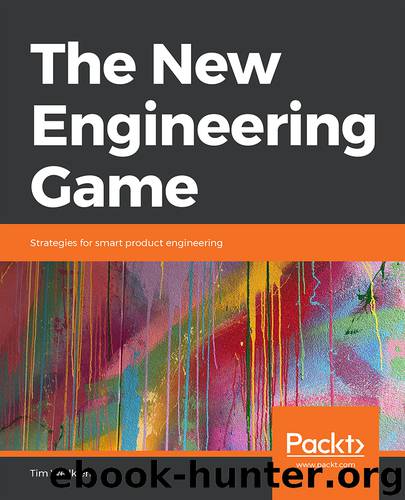The New Engineering Game by Tim Weilkiens

Author:Tim Weilkiens
Language: eng
Format: epub
Publisher: Packt Publishing Pvt Ltd
Published: 2019-08-29T00:00:00+00:00
Figure 4.3: BMC template
The left side of the BMC covers the resources of the business. The right side covers the customer aspect, and the bottom depicts the financial foundation. The middle section of the canvas is about the value proposition.
Next, we have a more detailed look at the sections starting with the resources (#1 to #3) on the left side.
The Key Activities section (#1) lists the most important activities that are necessary to offer the value proposition, for example, building a community in social networks, or developing a supply chain that satisfies tough cost and time requirements.
Later, you should map the activities to business units and roles. A helpful tool for that step is functional architecture. The Functional Architecture section describes the functional architecture in the context of the development of a product. However, you can also apply the method at the business level. A business is also a special kind of complex system.
The Key Partners section (#2) lists external organizations and people who are essential for the business model, such as a supplier or a service provider. This section also includes networks such as supplier networks, that is, it has a particular focus on relationships instead of the partners themselves.
Finally, the Key Resources section (#3) contains the most important resources, such as employees, patents, money, customer relationships, or a building or location.
The right side of the BMC depicts the customer view (#4 to #6).
The Customer Relationships (#4) section describes which relationships are expected by the customers, and which relationships are planned or already established by the business, for example, personal on-site support, online support for free, self-service, automated services, or communities.
The Channels (#5) section covers communication with customers. A business can directly communicate with its customers through online portals or on-site stores. It is also possible to have indirect communication with the final customers, for example, via distributors.
The Customer Segments (#6) section lists the customers. The segments cluster customers with similar needs and attributes, such as mass-market, males, females, older people, and academic people.
The bottom of the canvas depicts the financial fundament of the business. The Cost Structure (#7) section lists the central cost positions of the business model. You should distinguish between fixed costs that are independent of the number of sales, such as salaries, and variable costs, such as supplies.
Part of the cost structure is also the cost strategy. You can focus on minimizing all your costs, or you can focus on increasing the value of your products or services.
The Revenue Stream (#8) section describes how the business makes income. There are several ways to generate a revenue stream. The customer segments or channels can also distinguish it.
The middle of the canvas depicts the central aspect of a business model: the Value Propositions (#9), that is, the products and services offered by the business and the value for the customers. They distinguish the business from its competitors. Besides the functionality provided by the product or services, quality is a crucial part of the value proposition. Quality attributes include, for example, performance, price, accessibility, or newness.
Download
This site does not store any files on its server. We only index and link to content provided by other sites. Please contact the content providers to delete copyright contents if any and email us, we'll remove relevant links or contents immediately.
Algorithms of the Intelligent Web by Haralambos Marmanis;Dmitry Babenko(8517)
Building Statistical Models in Python by Huy Hoang Nguyen & Paul N Adams & Stuart J Miller(7283)
Azure Data and AI Architect Handbook by Olivier Mertens & Breght Van Baelen(7278)
Serverless Machine Learning with Amazon Redshift ML by Debu Panda & Phil Bates & Bhanu Pittampally & Sumeet Joshi(7167)
Data Wrangling on AWS by Navnit Shukla | Sankar M | Sam Palani(6932)
Driving Data Quality with Data Contracts by Andrew Jones(6912)
Machine Learning Model Serving Patterns and Best Practices by Md Johirul Islam(6657)
Learning SQL by Alan Beaulieu(6151)
Weapons of Math Destruction by Cathy O'Neil(6073)
Big Data Analysis with Python by Ivan Marin(5684)
Data Engineering with dbt by Roberto Zagni(4672)
Solidity Programming Essentials by Ritesh Modi(4336)
Time Series Analysis with Python Cookbook by Tarek A. Atwan(4174)
Pandas Cookbook by Theodore Petrou(3900)
Blockchain Basics by Daniel Drescher(3418)
Hands-On Machine Learning for Algorithmic Trading by Stefan Jansen(2953)
Natural Language Processing with Java Cookbook by Richard M. Reese(2902)
Feature Store for Machine Learning by Jayanth Kumar M J(2857)
Learn T-SQL Querying by Pam Lahoud & Pedro Lopes(2842)
